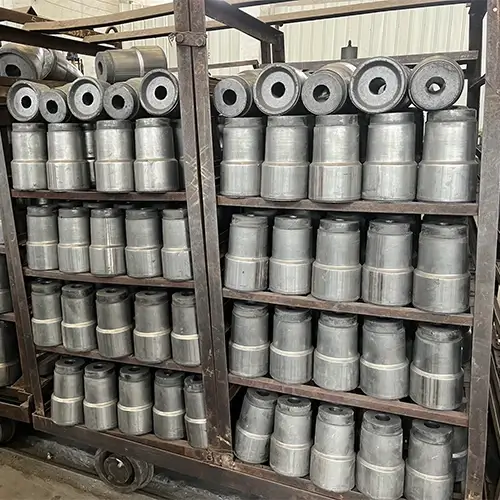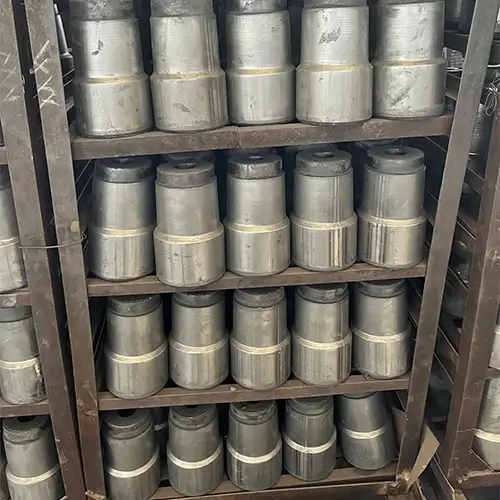Steel leakage accidents in the sliding nozzle mechanism typically occur in the following five locations:
- Steel seepage between the base brick and the ladle bottom;
- Steel seepage between the upper nozzle and the nozzle base brick;
- Steel seepage between the upper nozzle and the upper slide;
- Steel seepage between the upper and lower slides;
- Steel seepage between the lower slide and the lower nozzle.
The specific reasons may include the following problems:
1.Sliding gate mechanism reasons
(1) The sliding mechanism can be significantly deformed due to prolonged use in high temperatures or accidental collisions during operation. This can lead to uneven force distribution across the slide plates, creating small gaps in areas with low force distribution, potentially causing steel seepage between the slide plates.
(2)The sliding trolley that mounts the lower slide plate can gradually develop misalignment with the upper slide plate mechanism due to prolonged loading and unloading, resulting in a small gap between the upper and lower slide plates.
(3)The springs used in the mechanism can deform and fail due to prolonged use in high-temperature environments, even before reaching their service life. Under the static pressure of molten steel, gaps can form between the slide plates, potentially causing steel seepage between the plates and, in severe cases, even the entire mechanism can be worn through.
(4)The drain nozzle tightening sleeve can be deformed, causing the drain nozzle to be installed incorrectly, or the snap fasteners on the drain nozzle tightening sleeve trolley can be worn due to prolonged use, resulting in poor tightening between the drain nozzle and the lower slide plate, causing steel seepage.
2.Reasons for skateboarding
(1) The surface flatness of the slide plate does not meet the requirements; the flatness is low, resulting in micro-wave gaps between the slide plates.
(2) There are problems with the slide plate quality. During casting, especially on the secondary slide plate during continuous casting, the surface may be severely scratched, or a horseshoe-shaped melt loss may form at the slide plate opening. Molten steel can penetrate into the deeper scratches, where the temperature is relatively low, and condense, forming steel jams. If the slide plates continue to operate, especially during long reciprocating strokes during continuous casting, the jams may widen the gaps between the slide plates, causing steel leaks.
3.On-site operation reasons
(1) The refractory mortar is not properly blended, with the appropriate consistency. If the mortar is too thin during the nozzle installation, it will be squeezed out and provide poor support, while if it is too thick, it will not spread properly. Furthermore, when using high-pressure compressed air to blow out residual mortar in the nozzle eye, overly thin refractory mortar will create gaps, creating a risk of steel seepage from the nozzle.
(2) Dry refractory mortar inside the nozzle mechanism has not been cleaned properly, or there is steel slag. A small amount of refractory mortar remains on the slide plate, and due to negligence during use, it is mixed with granular dry refractory slag when applying the mortar to the nozzle, creating numerous production hazards.
(3) Problems with continuous casting machine operation. After the ladle begins pouring, a large, long nozzle is attached to the nozzle for protective pouring. Avoid reciprocating the slide plate with the large nozzle in place. This can loosen the nozzle due to improper operation, potentially leading to steel seepage. Use a jog mode to adjust the flow rate instead.

4.Factors causing steel leakage accidents between ladle slides
(1) When pouring calcium-treated molten steel, the Ca and CaO in the molten steel react with the Al2O3 and SiO2 in the aluminum-carbon or aluminum-zirconium-carbon slide bricks, forming low-melting-point substances such as 12CaO·7SiO2 and 2CaO·SiO2·Al2O3. These low-melting substances are washed away by the molten steel, rapidly reducing the Al2O3 and SiO2 content on the slide brick surface. This leads to excessive wear on the working surface of the slide bricks, resulting in steel jams or leaks between the slide bricks.
(2) When the oxygen content in the molten steel is high, the carbon and graphite in the slide bricks oxidize, forming a decarburized layer. This increases the porosity and reduces the strength of the working surface of the slide bricks, exacerbating mechanical erosion and chemical attack by the molten steel. The formation of a decarburized layer: Carbon on the surface of the slide plate oxidizes at the pouring temperature (1550-1600°C), forming a decarburized layer. This increases the porosity of the slide plate’s working surface and reduces its strength. When it comes into contact with molten steel, FeO, MnO, and [Ca] in the molten steel diffuse and penetrate into the slide plate through the pores.
(3) The molten steel temperature in the ladle after tapping is too high, exceeding 1660°C in some heats. Without external refining to regulate the temperature, this exacerbates thermomechanical and thermochemical corrosion of the sliding nozzle refractory, leading to cracking, steel infiltration, and corrosion-induced steel leakage.
5.Preventive measures
1.Strengthen the acceptance and inspection of the mechanical part of the sliding gate
1) The slide plate, a key component of the sliding gate, must be carefully measured before use to ensure that the dimensional tolerances of all parts meet the specified requirements.
2) The sliding mechanism must be carefully inspected during each packaging operation. Deformed or cracked parts must be replaced, and any remaining steel debris inside the slide box must be cleaned.
2.Selection of high-quality refractory materials
1) The refractory material used for the sliding nozzle must have high high-temperature strength, especially the ladle base bricks. It must withstand mechanical damage during nozzle brick replacement and the erosion of molten steel, and must last the same life as the ladle lining.
2) It must have excellent thermal shock resistance and resist cracking during use.
3) It must have a high load softening point and excellent oxidation resistance, ensuring the aperture remains stable during use and free of dents, pitting, or roughness.
3.Optimize operations
1) Strengthen process control and carefully inspect refractory materials to ensure their appearance and internal quality.
2) Clean any residual steel and mud from the inner cavities of the nozzle and base bricks, refill with drainage sand, and increase the automatic pouring rate of molten steel to avoid oxygen burning during pouring.
3) Close the sliding nozzle promptly after pouring the molten steel in the ladle to prevent slag from flowing into the nozzle.
4) Adjust the hardness and amount of refractory mud based on the diameter expansion of the base and nozzle bricks and the depth of the nozzle brick recessed into the base plate.
5) Accelerate the turnover of the ladle to minimize thermal shock damage to the ladle’s refractory materials.
6) Install the slide plate in strict accordance with the operating instructions. Clean any debris from the mold frame, working surface, and back of the slide plate. Keep the slide plate fully open during oxygen burning.
7) Strengthen smelting process control to ensure the final molten steel temperature and strictly control the oxygen and calcium content of the molten steel at the final stage.
6.Safety operating procedures for ladle pouring workers
- Before pouring steel, the emergency drive system pressure of the ladle turret must be normal; otherwise, pouring is strictly prohibited.
- Wear protective gear when entering the work area. Do not wear oily gloves. Do not hold the connection between the hose and the oxygen pipe. The oxygen pipe must be at least 1500mm long.
- During the pouring process, ladle workers should closely monitor the ladle wall. If they notice reddening, steel leaking, or the sliding nozzle is out of control, they must immediately stop pouring and notify personnel on the platform and on the ground. The ladle must be transferred to the emergency ladle as quickly as possible according to operating procedures. (If the operators at the steel plant involved in the incident mentioned at the beginning of this article had followed this procedure, this major accident might have been avoided.)
- The emergency drive system must be inspected and tested weekly.
- When lifting the oxygen pipe, two steel wire ropes must be used and securely tied together before lifting to prevent the pipe from slipping and injuring personnel.
- The sliding nozzle can only be activated after the tundish has reached the pouring position. 7 Wear protective glasses when burning cold steel at the ladle nozzle with an oxygen tube or removing cold steel from the long nozzle bracket. Avoid pointing the oxygen tube directly at other operators to prevent burns.

